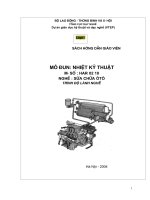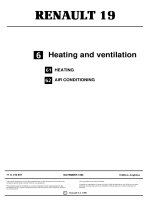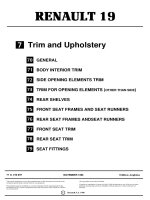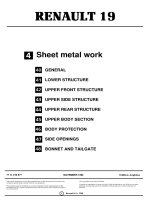Tài liệu hướng dẫnChevrolet Cobalt 2007 Owner Manual.pdf
Bạn đang xem bản rút gọn của tài liệu. Xem và tải ngay bản đầy đủ của tài liệu tại đây (2.57 MB, 444 trang )
Seats and Restraint Systems
....................... 7
Front Seats
.............................................. 9
Rear Seats
............................................. 16
Safety Belts
............................................ 18
Child Restraints
...................................... 40
Airbag System
........................................ 66
Restraint System Check
......................... 82
Features and Controls
................................ 85
Keys
....................................................... 87
Doors and Locks
.................................... 96
Windows
............................................... 102
Theft-Deterrent Systems
....................... 104
Starting and Operating Your Vehicle
..... 108
Mirrors
.................................................. 127
OnStar
®
System
................................... 129
Storage Areas
...................................... 133
Sunroof
................................................ 134
Instrument Panel
....................................... 135
Instrument Panel Overview
................... 138
Climate Controls
................................... 154
Warning Lights, Gages, and
Indicators
.......................................... 160
Driver Information Center (DIC)
............ 177
Audio System(s)
................................... 188
Driving Your Vehicle
................................. 221
Your Driving, the Road, and Your
Vehicle
.............................................. 222
Towing
................................................. 258
2007 Chevrolet Cobalt Owner Manual
M
1
Service and Appearance Care
.................. 271
Service
................................................. 274
Fuel
...................................................... 276
Checking Things Under the Hood
......... 282
Headlamp Aiming
................................. 323
Bulb Replacement
................................ 326
Windshield Wiper Blade Replacement
.... 333
Tires
..................................................... 334
Appearance Care
.................................. 369
Vehicle Identification
............................. 378
Electrical System
.................................. 378
Capacities and Specifications
................ 385
Maintenance Schedule
.............................. 387
Maintenance Schedule
.......................... 388
Customer Assistance Information
............. 409
Customer Assistance and Information
..... 410
Reporting Safety Defects
...................... 428
Index
.......................................................... 431
2
GENERAL MOTORS, GM, the GM Emblem,
CHEVROLET, the CHEVROLET Emblem, and the
name COBALT are registered trademarks of
General Motors Corporation.
This manual includes the latest information at the
time it was printed. We reserve the right to
make changes after that time without further
notice. For vehicles first sold in Canada, substitute
the name “General Motors of Canada Limited”
for Chevrolet Motor Division whenever it appears
in this manual.
This manual describes features that may be
available in this model, but your vehicle may not
be have all of them. For example, more than
one entertainment system may be offered or your
vehicle may have been ordered without a front
passenger or rear seats.
Keep this manual in the vehicle, so it will be there
if it is needed while you are on the road. If the
vehicle is sold, leave this manual in the vehicle.
Canadian Owners
A French language copy of this manual can be
obtained from your dealer or from:
Helm, Incorporated
P.O. Box 07130
Detroit, MI 48207
Litho in U.S.A.
Part No. 15864457 A First Printing
©
2006 General Motors Corporation. All Rights Reserved.
3
How to Use This Manual
Many people read the owner manual from
beginning to end when they first receive their new
vehicle. If this is done, it can help you learn
about the features and controls for the vehicle.
Pictures and words work together in the
owner manual to explain things.
Index
A good place to quickly locate information about
the vehicle is the Index in the back of the manual.
It is an alphabetical list of what is in the manual
and the page number where it can be found.
Safety Warnings and Symbols
There are a number of safety cautions in this
book. We use a box and the word CAUTION to
tell about things that could hurt you if you were to
ignore the warning.
{
CAUTION:
These mean there is something that could
hurt you or other people.
In the caution area, we tell you what the hazard is.
Then we tell you what to do to help avoid or
reduce the hazard. Please read these cautions. If
you do not, you or others could be hurt.
You will also find a
circle with a slash
through it in this book.
This safety symbol
means “Do Not,” “Do
Not do this” or “Do Not
let this happen.”
4
Vehicle Damage Warnings
Also, in this manual you will find these notices:
Notice: These mean there is something
that could damage your vehicle.
A notice tells about something that can damage
the vehicle. Many times, this damage would not be
covered by your vehicle’s warranty, and it could
be costly. But the notice will tell what to do to help
avoid the damage.
When you read other manuals, you might see
CAUTION and NOTICE warnings in different colors
or in different words.
There are also warning labels on the vehicle. They
use the same words, CAUTION or NOTICE.
Vehicle Symbols
The vehicle has components and labels that use
symbols instead of text. Symbols are shown along
with the text describing the operation or
information relating to a specific component,
control, message, gage, or indicator.
If you need help figuring out a specific name of a
component, gage, or indicator, reference the
following topics:
•
Seats and Restraint Systems in Section 1
•
Features and Controls in Section 2
•
Instrument Panel Overview in Section 3
•
Climate Controls in Section 3
•
Warning Lights, Gages, and Indicators in
Section 3
•
Audio System(s) in Section 3
•
Engine Compartment Overview in Section 5
5
These are some examples of symbols that may be found on the vehicle:
6
Front Seats ..................................................... 9
Manual Seats ................................................ 9
Driver Seat Height Adjuster ......................... 10
Manual Lumbar ........................................... 10
Heated Seats .............................................. 11
Reclining Seatbacks .................................... 12
Head Restraints .......................................... 14
Easy Entry Seat (Coupe) ............................ 15
Rear Seats .................................................... 16
Split Folding Rear Seat ............................... 16
Safety Belts .................................................. 18
Safety Belts: They Are for Everyone ........... 18
Questions and Answers About
Safety Belts ............................................. 22
How to Wear Safety Belts Properly ............. 23
Driver Position ............................................. 24
Shoulder Belt Height Adjustment ................. 31
Safety Belt Use During Pregnancy .............. 32
Right Front Passenger Position ................... 32
Rear Seat Passengers ................................ 33
Rear Safety Belt Comfort Guides ................ 36
Safety Belt Pretensioners ............................ 39
Safety Belt Extender ................................... 39
Child Restraints ............................................ 40
Older Children ............................................. 40
Infants and Young Children ......................... 43
Child Restraint Systems .............................. 47
Where to Put the Restraint .......................... 51
Lower Anchors and Tethers for
Children (LATCH) .................................... 53
Securing a Child Restraint in a Rear
Seat Position ........................................... 59
Securing a Child Restraint in the Right
Front Seat Position .................................. 62
Section 1 Seats and Restraint Systems
7
Airbag System .............................................. 66
Where Are the Airbags? .............................. 69
When Should an Airbag Inflate? .................. 71
What Makes an Airbag Inflate? ................... 73
How Does an Airbag Restrain? ................... 73
What Will You See After an Airbag
Inflates? ................................................... 74
Passenger Sensing System ......................... 75
Servicing Your Airbag-Equipped Vehicle ...... 80
Adding Equipment to Your
Airbag-Equipped Vehicle .......................... 81
Restraint System Check ............................... 82
Checking the Restraint Systems .................. 82
Replacing Restraint System Parts
After a Crash ........................................... 83
Section 1 Seats and Restraint Systems
8
Front Seats
Manual Seats
{
CAUTION:
You can lose control of the vehicle if you
try to adjust a manual driver’s seat while
the vehicle is moving. The sudden
movement could startle and confuse you,
or make you push a pedal when you do
not want to. Adjust the driver’s seat only
when the vehicle is not moving.
Lift the bar located under the front of the seat to
unlock it. Slide the seat to where you want it
and release the bar. Try to move the seat with your
body to be sure the seat is locked in place.
9
Driver Seat Height Adjuster
The driver’s seat height adjuster is located on the
outboard side of the seat.
To raise the seat, move the lever upward
repeatedly until the seat is at the desired height.
To lower the seat, move the lever downward
repeatedly until the seat is at the desired height.
Manual Lumbar
If your vehicle has
this feature, the knob
is located on the front
of the driver seat
lower cushion on the
inboard side.
Turn the knob clockwise or counterclockwise to
increase or decrease the lumbar support.
10
Heated Seats
Your vehicle may have heated front seats. The
switches are located on the instrument panel
above the climate control system.
Press the side of the
switch with the double
indicator lights to turn on
the heated seat at the
highest setting.
Both indicator lights will be lit to indicate that the
setting is on high. Press the side of the switch with
the single indicator light to go to the low setting.
The indicator light will be lit to indicate that
the setting is on low. Return the switch to the
center to turn off the heated seat.
If your vehicle has been turned off, the last heated
seat setting will be retained when the vehicle is
started again.
Driver’s Switch Shown,
Passenger’s Switch
Similar
11
Reclining Seatbacks
{
CAUTION:
You can lose control of the vehicle if
you try to adjust a manual driver’s seat
while the vehicle is moving. The sudden
movement could startle and confuse you,
or make you push a pedal when you do
not want to. Adjust the driver’s seat only
when the vehicle is not moving.
{
CAUTION:
If the seatback is not locked, it could
move forward in a sudden stop or crash.
That could cause injury to the person
sitting there. Always push and pull on
the seatback to be sure it is locked.
Your seats have manual reclining seatbacks.
The lever used to operate them is located on the
outboard side of the seats.
To recline the seatback, do the following:
1. Lift the recline lever.
2. Move the seatback to the desired position,
then release the lever to lock the seatback
in place.
3. Push and pull on the seatback to make sure
it is locked.
12
To return the seatback to an upright position, do
the following:
1. Lift the lever fully without applying pressure to
the seatback and the seatback will return to
the upright position.
2. Push and pull on the seatback to make sure it
is locked.
{
CAUTION:
Sitting in a reclined position when your
vehicle is in motion can be dangerous.
Even if you buckle up, your safety belts
cannot do their job when you are reclined
like this.
The shoulder belt cannot do its job
because it will not be against your body.
Instead, it will be in front of you. In a
crash, you could go into it, receiving neck
or other injuries.
The lap belt cannot do its job either. In a
crash, the belt could go up over your
abdomen. The belt forces would be there,
not at your pelvic bones. This could cause
serious internal injuries.
For proper protection when the vehicle is
in motion, have the seatback upright.
Then sit well back in the seat and wear
your safety belt properly.
Do not have a seatback reclined if your vehicle is
moving.
13
Head Restraints
Adjust the head restraint so that the top of the
restraint is at the same height as the top of
the occupant’s head. This position reduces the
chance of a neck injury in a crash.
Pull the head restraint
up to raise it. To lower
the head restraint,
press the button,
located on the top of the
seatback, and push
the restraint down.
14
Easy Entry Seat (Coupe)
{
CAUTION:
If the easy entry right front seat is not
locked, it can move. In a sudden stop or
crash, the person sitting there could be
injured. After you have used it, be sure to
push rearward on an easy entry seat to be
sure it is locked.
{
CAUTION:
If the seatback is not locked, it could
move forward in a sudden stop or crash.
That could cause injury to the person
sitting there. Always push and pull on the
seatback to be sure it is locked.
The front passenger seat can be used to easily
get in and out of the rear seat.
To use the easy entry seat, do the following:
1. Push down the easy entry seat handle located
on the rear of the seatback on the outboard
side to release the seatback.
2. Tilt the seatback forward completely while
pushing the seat forward.
3. Move the seatback to its original position after
someone gets into the rear seat area. Make
sure the seatback is locked.
4. Move the seat rearward until it locks into place.
15
Rear Seats
Split Folding Rear Seat
You can fold either side of the rear seatback down
for more cargo space.
To lower the rear seatback, follow these steps:
1. Open the trunk and pull one or both of the
small handles located in the center of the
trunk.
Notice: Folding a rear seat with the safety
belts still fastened may cause damage to the
seat or the safety belts. Always unbuckle
the safety belts and return them to their normal
stowed position before folding a rear seat.
2. Once the handle is pulled, the seatback can
be pushed open through the trunk, or pulled
down from the inside of the vehicle.
16
To raise the rear seatback, lift it up and push
rearward until you hear a click. Push and pull on
the seatback to be sure it is locked into place.
{
CAUTION:
If the seatback is not locked, it could
move forward in a sudden stop or crash.
That could cause injury to the person
sitting there. Always pull forward on the
top of the seatback at the area of the
latch to be sure it is locked.
{
CAUTION:
A safety belt that is improperly routed,
not properly attached, or twisted will not
provide the protection needed in a crash.
The person wearing the belt could be
seriously injured. After raising the rear
seatback, always check to be sure that
the safety belts are properly routed and
attached, and are not twisted.
17
Safety Belts
Safety Belts: They Are for Everyone
This part of the manual tells you how to use
safety belts properly. It also tells you some things
you should not do with safety belts.
{
CAUTION:
Do not let anyone ride where he or she
cannot wear a safety belt properly. If you
are in a crash and you are not wearing a
safety belt, your injuries can be much
worse. You can hit things inside the
vehicle or be ejected from it. You can be
seriously injured or killed. In the same
crash, you might not be, if you are
buckled up. Always fasten your safety
belt, and check that your passengers’
belts are fastened properly too.
{
CAUTION:
It is extremely dangerous to ride in a
cargo area, inside or outside of a vehicle.
In a collision, people riding in these areas
are more likely to be seriously injured or
killed. Do not allow people to ride in any
area of your vehicle that is not equipped
with seats and safety belts. Be sure
everyone in your vehicle is in a seat and
using a safety belt properly.
Your vehicle has indicators to remind you and your
passengers to buckle your safety belts. See Safety
Belt Reminder Light on page 162 and Passenger
Safety Belt Reminder Light on page 163.
18
In most states and in all Canadian provinces, the
law says to wear safety belts. Here is why:
They work.
You never know if you will be in a crash. If you do
have a crash, you do not know if it will be a
bad one.
A few crashes are mild, and some crashes can be
so serious that even buckled up, a person
would not survive. But most crashes are in
between. In many of them, people who buckle up
can survive and sometimes walk away. Without
belts they could have been badly hurt or killed.
After more than 40 years of safety belts in
vehicles, the facts are clear. In most crashes
buckling up does matter... a lot!
Why Safety Belts Work
When you ride in or on anything, you go as fast
as it goes.
Take the simplest vehicle. Suppose it is just a
seat on wheels.
19
Put someone on it. Get it up to speed. Then stop the vehicle.
The rider does not stop.
20
The person keeps going until stopped by
something. In a real vehicle, it could be the
windshield...
or the instrument panel...
21
or the safety belts!
With safety belts, you slow down as the vehicle
does. You get more time to stop. You stop
over more distance, and your strongest bones
take the forces. That is why safety belts
make such good sense.
Questions and Answers About
Safety Belts
Q:
Will I be trapped in the vehicle after an
accident if I am wearing a safety belt?
A:
You could be — whether you are wearing a
safety belt or not. But you can unbuckle a
safety belt, even if you are upside down. And
your chance of being conscious during and
after an accident, so you can unbuckle and get
out, is much greater if you are belted.
Q:
If my vehicle has airbags, why should I
have to wear safety belts?
A:
Airbags are supplemental systems only; so
they work with safety belts — not instead of
them. Every airbag system ever offered
for sale has required the use of safety belts.
Even if you are in a vehicle that has airbags,
you still have to buckle up to get the most
protection. That is true not only in frontal
collisions, but especially in side and other
collisions.
22
Q:
If I am a good driver, and I never drive far
from home, why should I wear safety belts?
A:
You may be an excellent driver, but if you are
in an accident — even one that is not your
fault — you and your passengers can be hurt.
Being a good driver does not protect you
from things beyond your control, such as bad
drivers.
Most accidents occur within 25 miles (40 km)
of home. And the greatest number of
serious injuries and deaths occur at speeds
of less than 40 mph (65 km/h).
Safety belts are for everyone.
How to Wear Safety Belts Properly
This part is only for people of adult size.
Be aware that there are special things to know
about safety belts and children. And there
are different rules for smaller children and babies.
If a child will be riding in your vehicle, see
Older Children on page 40 or Infants and Young
Children on page 43. Follow those rules for
everyone’s protection.
First, you will want to know which restraint
systems your vehicle has.
We will start with the driver position.
23
Driver Position
Lap-Shoulder Belt
The driver has a lap-shoulder belt. Here is how
to wear it properly.
1. Close and lock the door.
2. Adjust the seat so you can sit up straight.
To see how, see “Seats” in the Index.
3. Pick up the latch plate and pull the belt across
you. Do not let it get twisted.
The lap-shoulder belt may lock if you pull the
belt across you very quickly. If this happens,
let the belt go back slightly to unlock it.
Then pull the belt across you more slowly.
4. Push the latch plate into the buckle until
it clicks.
Pull up on the latch plate to make sure it
is secure. If the belt is not long enough, see
Safety Belt Extender on page 39.
Make sure the release button on the buckle is
positioned so you would be able to unbuckle
the safety belt quickly if you ever had to.
5. Move the shoulder belt height adjuster to
the height that is right for you. Improper
shoulder belt height adjustment could reduce
the effectiveness of the safety belt in a
crash. See Shoulder Belt Height Adjustment
on page 31.
24
6. To make the lap part tight, pull up on the
shoulder belt.
It may be necessary to pull stitching on the
safety belt through the latch plate to fully
tighten the lap belt on smaller occupants.
The lap part of the belt should be worn low and
snug on the hips, just touching the thighs. In a
crash, this applies force to the strong pelvic bones.
And you would be less likely to slide under the lap
belt. If you slid under it, the belt would apply force at
your abdomen. This could cause serious or even
fatal injuries. The shoulder belt should go over the
shoulder and across the chest. These parts of the
body are best able to take belt restraining forces.
The safety belt locks if there is a sudden stop
or crash.
25









